Tālī and Khālī – ताली और खाली
Quick Definition: The two types of vibhags (divisions) in a tal:
- Tali Vibhags: stressed, indicated by a clap
- Khali Vibhags: unstressed, indicated by a wave
Literal Meanings:
- Tali: clap
- Kali: empty; without
Notes:
- Tali and khali can also refer to strokes, or sections, of tabla compositions which are played with an open bass drum (tali) or a closed bass drum (khali) (see Tali-Khali Counterparts).
- The term bharī – भरी (meaning "full" or "weight") is also used in place of tali. Their meanings are the same in the contexts of tal and tabla compositions.
Example of Tali and Khali Vibhags in Tintal
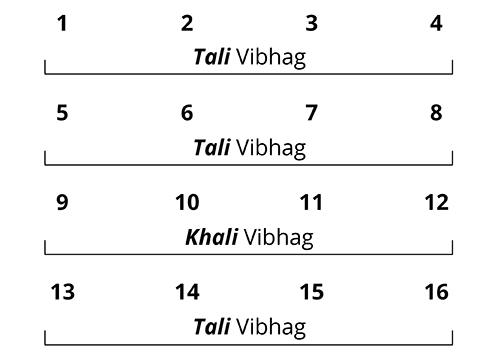
Introduction to Tali and Khali
As we saw in the last section, the matras (beats) in a tal are divided into sections called vibhags. But not all vibhags are the same; vibhags are either tali or khali:
- Tali vibhags are stressed.
- Khali vibhags are unstressed.
These qualities of tali and khali, stressed and unstressed, give every tal a particular stress pattern.
For example, in the diagram of tintal above, we see a stress pattern of tali-tali-khali-tali, or stressed-stressed-unstressed-stressed, and not just 4-4-4-4.
However, as we discuss below, the qualities of tali and khali are conceptual, and we don’t always hear them in the music. Tali and khali vibhags are part of the underlying structure of a tal that is always present, whether or not it is shown the music.
And yet learning a tal’s tali-khali pattern is one of the best ways to follow classical tabla in performance.
Tali-Khali Patterns and Timekeeping
Musicians often show the tali-khali pattern of a tal when they keep time with the hands:
- Tali Vibhags are indicated by a clap.
- Khali Vibhags are indicated by a wave.
Keeping time in this way is an ancient practice, and explains why we use the term tal, which means “clap”. The term khali means "without" or "empty"; in other words, "without clap" or "empty of stress". In this way, claps and waves indicate the stress or non-stress of a vibhag.
Keeping time is an important part of tabla training, but it is also a simple way for listeners to learn the structure of any tal. We look more at timekeeping below.
Tali-Khali Stress Patterns
Every tal’s tali-khali pattern creates a particular shape, or contour. This pattern is created both by the stress pattern, and by the length of each vibhag.
For example, we know that tintal has a vibhag structure of 4–4–4–4. If all the vibhags were the same, it would be easy to get lost. But with a stress pattern of tali-tali-khali-tali, we see the shape of the tal more clearly: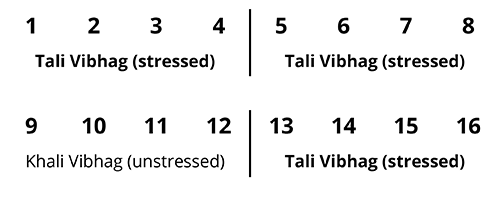
Jhaptal also has a pattern of tali-tali-khali-tali, but in divisions of 2–3–2–3, so the feeling is very different:
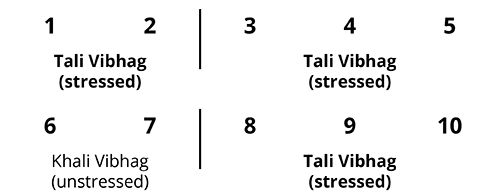
And rupak tal has a pattern of khali-tali-tali divided 3–2–2:

Vibhags are indicated by claps and waves
Classical Indian musicians will sometimes show the vibhags of a tal with claps and waves of the hand:
- Tali vibhags are indicated by a clap on the first matra of a tali vibhag.
- Khali vibhags are indicated by a wave on the first matra of a khali vibhag.
In Hindi, this practice might be called tali dikhana ("showing clap") or tali bhajana ("playing clap"). These both essentially mean “showing the tal”. In English, we call this practice "keeping time".
Keeping time is a very important part of tabla training. We do this when we speak compositions, while we listen, or when we keep time for other musicians.
For listeners, keeping time is also the easiest way to both understand a tal’s structure, and to follow a live performance.
Timekeeping Pattern in Tintal
Below is an example in tintal, which has a pattern of tali-tali-khali-tali, divided 4-4-4-4. This gives us a timekeeping pattern of clap-clap-wave-clap:
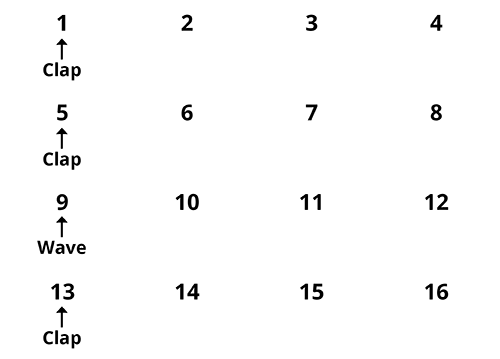
Timekeeping Pattern in Jhaptal
Jhaptal’s pattern of tali-tali-khali-tali also becomes clap-clap-wave-clap, but with the different divisions of 2–3–2–3:
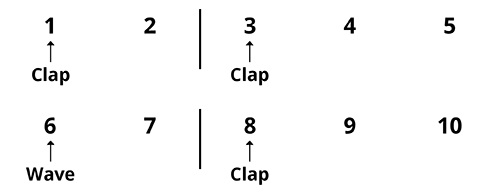
Timekeeping Pattern in Rupak Tal
And rupak’s pattern of khali-tali-tali becomes wave-clap-clap (3-2-2):

If you are a listener, I strongly recommend that your learn to keep time at least for tintal. See the Listener’s Guide for guidance, and the section on Keeping Time for specific techniques.
Tali and khali vibhags are not always shown in the music
It is important to understand that the stress, or non-stress, of the vibhags is mostly conceptual; tali and khali are qualities given to a vibhag. But what we play over tali vibhags is not always stressed, and what we play over khali vibhags is not always unstressed.
Throughout the classical repertoire, we see a wide range of connection between a tal’s vibhag structure and what the tabla is doing on top:
- Thekas follow the vibhags most clearly (though not always).
- Cyclic forms such as the kayda and rela, often reflect the tali-khali stress pattern of the tal, but they can also change speeds and lengths, and so they do not always align with the vibhags.
- Cadential forms, such as the tihai, tukra, and chakradar, usually do not follow the tali-khali patterns of the tal at all.
So the music that you hear is not necessarily tied to the tal’s structure. And yet a tal’s tali-khali stress pattern is always there underneath.
References
Clayton, Martin. Time in Indian Music: Rhythm, Metre, and Form in North Indian Rāg Performance. Oxford: Oxford University Press, 2000.
Misra, Chhote Lal. Tal Prasoon. New Delhi: Kanishka Publishers, 2004. (Hindi)
Stewart, Rebecca Marie. The Tabla in Perspective. Unpublished Ph.D. thesis, University of California, Los Angeles, 1974.